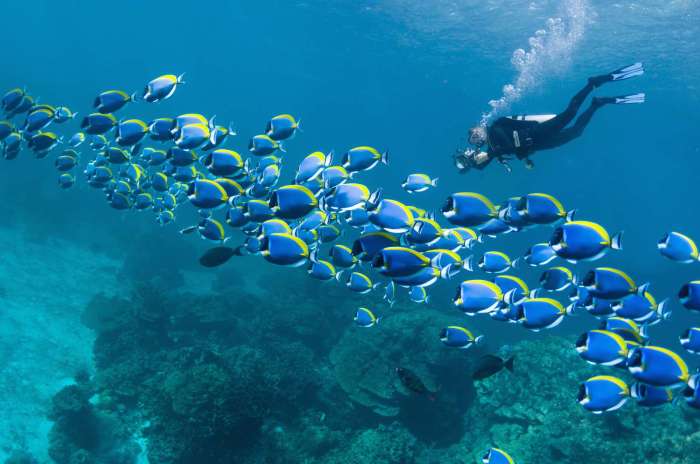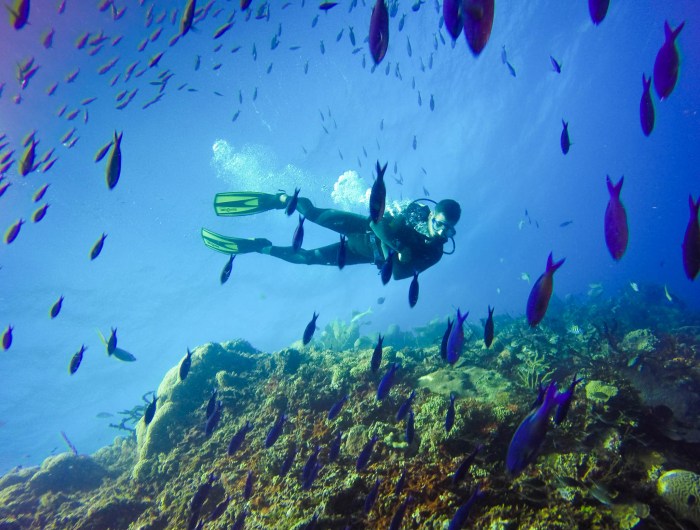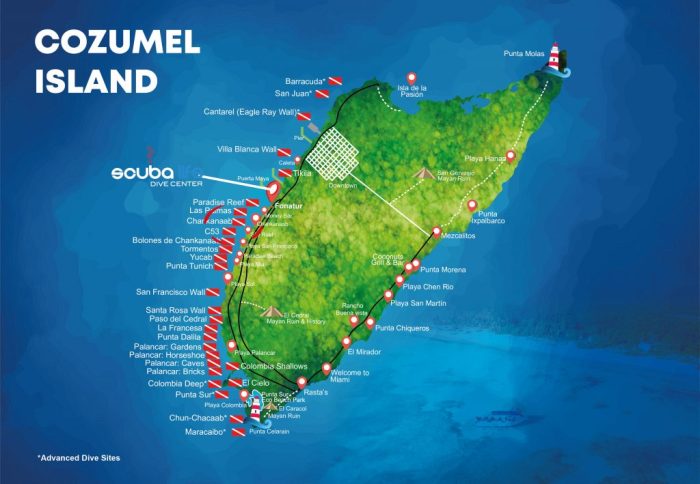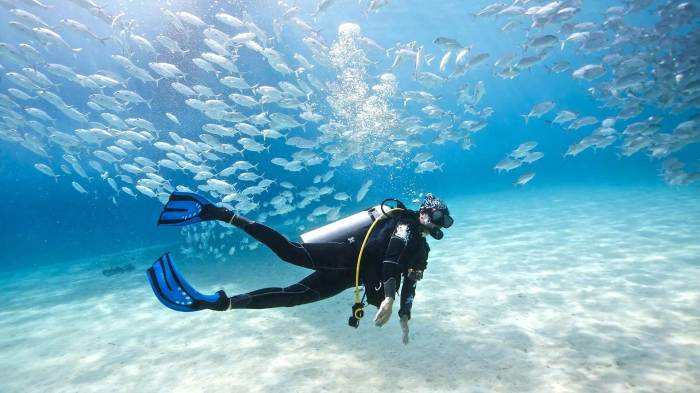Immerse yourself in the captivating realm of scuba diving locations, where breathtaking underwater wonders await. From vibrant coral reefs teeming with marine life to enigmatic shipwrecks that whisper tales of the past, each destination offers a unique experience that will leave you spellbound.
Whether you’re a seasoned diver or just starting your underwater adventure, this guide will provide you with invaluable insights into selecting the perfect scuba diving location, ensuring an unforgettable and safe journey into the depths of the ocean.
Global Scuba Diving Destinations

The world’s oceans offer a vast array of scuba diving destinations, each with its unique attractions and challenges. From the vibrant coral reefs of the Caribbean to the kelp forests of California, there is a dive site to suit every taste and skill level.
The Great Barrier Reef, Australia
The Great Barrier Reef is the world’s largest coral reef system, stretching over 2,300 kilometers (1,400 miles) along the coast of Queensland, Australia. The reef is home to over 1,500 species of fish, 400 species of coral, and 4,000 species of mollusks. Divers can explore the reef’s many dive sites, including the SS Yongala, a 110-meter (360-foot) shipwreck that is now home to a thriving marine ecosystem.
Cozumel, Mexico
Cozumel is a Mexican island in the Caribbean Sea that is known for its world-class scuba diving. The island’s coral reefs are home to a wide variety of marine life, including eagle rays, sea turtles, and sharks. Divers can explore the island’s many dive sites, including the Palancar Reef, which is considered one of the best dive sites in the world.
Galapagos Islands, Ecuador
The Galapagos Islands are a group of volcanic islands in the Pacific Ocean that are known for their unique wildlife. The islands are home to a variety of marine life, including sea lions, penguins, and sharks. Divers can explore the islands’ many dive sites, including the Gordon Rocks, which is known for its large schools of hammerhead sharks.
Factors to Consider When Choosing a Scuba Diving Location
When selecting a scuba diving destination, it’s crucial to consider several key factors to ensure an optimal experience. These factors include water conditions, visibility, marine life, and accessibility.
Water conditions play a significant role in the overall diving experience. Temperature, currents, and visibility can vary significantly between different dive sites. Divers should choose locations that offer favorable conditions for their skill level and preferences. Cold water diving, for example, requires specialized gear and training, while warm water diving offers a more comfortable experience for beginners.
Visibility is another important consideration. Divers want clear waters to fully appreciate the underwater world. Factors such as plankton blooms, sediment, and depth can affect visibility. Divers should research potential dive sites to determine the typical visibility conditions.
The diversity and abundance of marine life are also key factors to consider. Divers should choose locations known for their vibrant marine ecosystems. Reefs, wrecks, and underwater caves often attract a wide variety of marine life, including fish, invertebrates, and even large predators.
Finally, accessibility is an important consideration. Divers should choose locations that are easily accessible by boat or shore. Factors such as distance from major airports, transportation options, and dive site infrastructure should be taken into account.
By carefully considering these factors, divers can choose a scuba diving destination that meets their needs and provides an unforgettable experience.
Safety and Precautions for Scuba Diving

Scuba diving offers an unforgettable experience, but it’s essential to prioritize safety to ensure a positive and risk-free adventure. This section will delve into the safety protocols and precautions that every diver should adhere to.
Proper Training and Certification
Before embarking on a scuba diving expedition, it’s crucial to obtain proper training and certification from a recognized organization. These programs provide comprehensive knowledge and skills in diving techniques, emergency procedures, and safety guidelines. Certified divers demonstrate competence and are better equipped to handle potential risks underwater.
Equipment Maintenance
Regular maintenance of scuba diving equipment is paramount for safety. This includes inspecting and servicing regulators, buoyancy compensators, tanks, and other gear. Proper maintenance ensures equipment is functioning optimally, reducing the likelihood of equipment failure or malfunction during a dive.
Emergency Procedures
Understanding emergency procedures is essential for divers. These include protocols for lost divers, equipment failure, and decompression sickness. Divers should be familiar with the emergency signals and procedures to communicate with their dive buddy and surface personnel in case of an emergency.
There are a lot of beautiful scuba diving locations around the world, so it can be hard to know where to start. If you’re looking for some inspiration, check out Hello world! for a list of some of the best spots.
Whether you’re a beginner or an experienced diver, there’s sure to be something for you. And once you’ve chosen your destination, be sure to do your research and find out what kind of diving conditions you can expect.
Common Diving Hazards, Scuba diving locations
Divers should be aware of common hazards underwater, such as decompression sickness, nitrogen narcosis, and hypothermia. By understanding the symptoms and preventive measures for these hazards, divers can minimize the risks associated with scuba diving.
Marine Life Encounters
Diving into the ocean’s depths offers an extraordinary opportunity to witness the wonders of marine life firsthand. Divers may encounter a diverse array of creatures, from vibrant fish and graceful corals to majestic sea turtles and playful dolphins.
Fish Species
The underwater world is teeming with an astonishing variety of fish species. Divers may encounter colorful reef fish, such as clownfish, angelfish, and parrotfish, that inhabit vibrant coral reefs. Pelagic fish, such as tuna, mackerel, and sharks, roam the open ocean. Bottom-dwelling fish, such as flounders and stingrays, blend seamlessly with the sandy seafloor.
Corals and Invertebrates
Coral reefs are vibrant underwater ecosystems that provide habitat for a multitude of marine life. Divers may encounter hard corals, which form massive structures, and soft corals, which resemble delicate flowers. In addition, a wide range of invertebrates, including sea stars, sea urchins, and octopuses, add to the diversity of coral reef ecosystems.
Other Underwater Creatures
The ocean is home to a plethora of other fascinating underwater creatures. Divers may encounter graceful sea turtles, gliding through the water with ease. Dolphins, known for their playful nature, often interact with divers. Marine mammals, such as whales and seals, can also be observed in certain locations.
It is essential to respect marine ecosystems and avoid harmful interactions with wildlife. Divers should maintain a safe distance from marine animals, avoid touching or disturbing them, and refrain from using flash photography that may disrupt their behavior.
Historical and Cultural Significance of Scuba Diving Locations

Scuba diving has opened up a new world of exploration, not only for marine life enthusiasts but also for historians and archaeologists. Underwater historical sites provide valuable insights into past civilizations, shipwrecks, and cultural practices.
Archaeological Discoveries
Scuba diving has facilitated the discovery of numerous underwater archaeological sites, such as the ancient city of Thonis-Heracleion in Egypt, submerged beneath the Mediterranean Sea. The exploration of these sites has yielded artifacts, structures, and inscriptions that have shed light on ancient cultures, trade routes, and maritime practices.
Marine Conservation Efforts
Scuba diving has played a crucial role in marine conservation efforts. By observing and documenting underwater ecosystems, scientists and conservationists can better understand the impact of human activities on marine life. This knowledge has led to the establishment of marine protected areas, conservation programs, and educational initiatives aimed at preserving the health and diversity of our oceans.
Examples of Underwater Historical Sites
* Yonaguni Monument, Japan: An enigmatic underwater structure resembling a castle or pyramid, believed to be the remains of an ancient civilization.
* SS Thistlegorm, Egypt: A British merchant ship sunk during World War II, now a popular dive site known for its well-preserved cargo and artifacts.
* Great Blue Hole, Belize: A large underwater sinkhole that has attracted divers and scientists due to its unique geological formations and diverse marine life.
* Underwater Museum of Art, Mexico: An artificial reef featuring over 500 sculptures by renowned artists, providing a unique blend of art and marine conservation.
Planning and Logistics for Scuba Diving Trips: Scuba Diving Locations

Embarking on a scuba diving trip requires careful planning and meticulous logistics. From selecting the ideal time of year to packing the essential gear, each step plays a crucial role in ensuring a safe, enjoyable, and unforgettable experience.
The first step in planning your scuba diving trip is choosing the right time of year. Different destinations have varying seasons that offer optimal diving conditions. Research the weather patterns, water temperature, and visibility at your chosen location to determine the best time to visit.
Booking Accommodations
Secure your accommodations well in advance, especially if you’re traveling during peak season. Consider the proximity of your hotel or resort to the dive sites, as well as amenities such as a dive center or equipment rental services.
Arranging Transportation
Plan your transportation to and from the airport, as well as to and from the dive sites. Research local transportation options, such as taxis, rental cars, or shuttle services, to find the most convenient and cost-effective method.
Packing Essential Gear
Pack all necessary scuba diving gear, including your wetsuit or drysuit, buoyancy compensator device (BCD), regulator, and mask. Don’t forget essential accessories like dive fins, a dive computer, and a dive light. Ensure your gear is in good working condition and serviced regularly.
Preparing for Different Diving Conditions
Research the dive sites you plan to visit and be prepared for different diving conditions. Pack appropriate clothing and gear for varying water temperatures, currents, and visibility. Consider bringing a dive skin or thermal protection for colder waters.
Ultimate Conclusion

As you embark on your scuba diving adventures, remember to embrace the beauty and fragility of the marine environment. By respecting local ecosystems and following safety protocols, you can help preserve these underwater treasures for generations to come.
Helpful Answers
What are some of the most popular scuba diving destinations?
The Great Barrier Reef in Australia, the Maldives, the Red Sea in Egypt, the Galapagos Islands, and the Caribbean Sea are among the most sought-after scuba diving destinations worldwide.
What factors should I consider when choosing a scuba diving location?
Water conditions, visibility, marine life diversity, accessibility, and safety protocols are key factors to consider when selecting a scuba diving destination.
What safety precautions should I take while scuba diving?
Proper training, certification, and equipment maintenance are crucial for safe scuba diving. Always dive with a buddy, follow dive plans, and respect the limits of your experience.